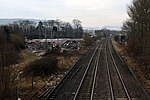Churchend, Eastington
Hamlets in GloucestershireStroud District

Churchend is a hamlet in Gloucestershire, England, 4 miles (6.4 km) west of Stroud. It is part of the civil parish of Eastington. The church of St Michael and All Angels dates from the 14th century and is a grade II* listed building.
Excerpt from the Wikipedia article Churchend, Eastington (License: CC BY-SA 3.0, Authors, Images).Churchend, Eastington
Spring Hill,
Geographical coordinates (GPS) Address Nearby Places Show on map
Geographical coordinates (GPS)
| Latitude | Longitude |
|---|---|
| N 51.751 ° | E -2.317 ° |
Address
Spring Hill
Spring Hill
GL10 3RX , Eastington
England, United Kingdom
Open on Google Maps









